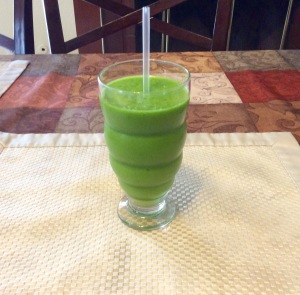This makes for a great eye opener but It’s refreshing any time of day.

1 cup water
1cup romaine lettuce
1 cup fresh spinach
thin slice of fresh lemon (including the peel)
4 frozen pineapple cubes (or 4oz frozen pineapple)
2 frozen mango cubes (or 2oz frozen mango)
1 Stevia packet (or more to taste)
- Placed all into the Vitamix container in the order listed and secure lid.
- Select Variable 1.
- Turn machine on and quickly increase speed to Variable 10, then to High.
- Blend for 1 minute or until desired consistency is reached. Use the tamper if needed to push the ingredients into the blades.
Food Tip: Any of your favorite greens will work in this smoothie. Spinach and romaine lettuce are good starters for the novice green smoothie drinker because the fruit masks the taste of the greens. As you get more accustomed to the taste, try removing the Stevia and some of the fruit. That will retrain your palate into not always needing food to be sweet to taste good.
Time Tip: As with my other smoothie recipes, I save time by pureeing the fruit and freezing them in ice cube trays. No need to separate large chunks of frozen fruit. Also, I can add exactly the desired amount of fruit keeping the flavor just like I like it or give me option to change it up a bit.
Money Tip: Buy your greens at a food warehouse such as Costco or Sam’s Club. As soon as you open the bags, fill gallon-sized freezer bags, label and date them, then put them straight into the freezer. Use up the fresh greens in the refrigerator then begin using the frozen greens. No more tossing half of your greens in the trash 3 days after you bring the home and running out to by more. No waste ALWAYS means more money in your pocket.

